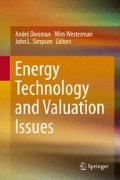Abstract
This chapter revisits the importance of domestic versus global economic factors in explaining future spot gas prices in the domestic natural gas markets of the US and the UK, which arguably are the two leading major Western economies engaged in ongoing market reform. The chapter is based on Simpson (J Energy Markets 3(1), 2011) with a significant rewrite around an update of data, analysis and conclusions. The study, involving a comparison of progress in each economy towards natural gas market liberalization, should be interesting for policy makers globally. Assuming that market liberalization will in due course produce economic welfare benefits, the study posits that the relative importance of these factors is one indicator of the extent of natural gas market deregulation in each market. Updating the Simpson (J Energy Markets 3(1), 2011) study, lagged daily oil and gas data from 3rd January 2000 to 28th July 2014 are analyzed and a proven structural break is introduced to control for time varying relationships as affected by the global financial crisis. Global oil futures prices together with domestic gas futures prices are not shown to be very strong predictors of future domestic spot gas prices, thus indicating some progress in US and UK domestic gas market deregulation. However cointegration and Granger causality studies show that there is some distance to go in market liberalization for both the US and the UK. It is up to further research to explain why this is the case in terms of policy actions taken.
Access this chapter
Tax calculation will be finalised at checkout
Purchases are for personal use only
Notes
- 1.
Generalized Autoregressive Conditional Heteroscedasticity model.
- 2.
Note: The USA is the larger of the two natural gas markets, estimated at more than 660 billion cubic metres compared to 100 billion cubic metres in the UK in 2007.
- 3.
Values of F test statistics are 929.028, 2,787.082, 375.970 and 1,127.909 respectively.
- 4.
Values of test statistics are 343.457 and 359.727 respectively.
References
Adelman MA, Watkins GC (2005) US oil and natural gas reserve prices, 1982–2003. Energy Econ 27(4):553–571
Asche F (2000) European market integration for gas? Volume flexibility and political risk. CESifo Working paper, Number 358, November 2000
Asche F (2006) The UK market for natural gas, oil and electricity: are the prices de-coupled? Energy J 27(2):27–40
Dickey DA, Fuller WA (1981) Likelihood ratio statistics for autoregressive time series within a unit root. Econometrica 49:1022–1057
Ewing BT, Malik F, Ozfidan O (2002) Volatility transmission in the oil and natural gas markets. Energy Econ 24(6):525–538
Geman H, Ohana S (2009) Forward curves, scarcity and price volatility in oil and natural gas markets. Energy Econ 31(4):576–585
Granger CWJ (1988) Some recent developments in a concept of causality. J Econ 39:199–211
Herbert JH (1993) The relation of monthly spot to futures prices for natural gas. Energy 18(11):1119–1124
Herbert JH, Kreil E (1996) US natural gas markets: how efficient are they? Energy Policy 24(1):1–5
Jarque CM, Bera AK (1987) A test for normality of observations and regression residuals. Int Stat Rev 55:163–172
Johansen S (1988) Statistical analysis of cointegration vectors. J Econ Dyn Control 12:231–254
Krichene N (2002) World crude oil and natural gas: a demand and supply model. Energy Econ 24(6):557–576
Marzo M, Zagaglia P (2008) A note on the conditional correlation between energy prices: evidence from future markets. Energy Econ 30(5):2454–2458
Mazighi, AEH (2005) Henry hub and national balancing point prices: what will be the international gas price reference. Organization of Petroleum Exporting Countries, Research paper, September 2005
Modjtahedi B, Movassagh N (2005) Natural gas futures: bias, predictive performance, and the theory of storage. Energy Econ 27(4):617–637
Mu X (2007) Weather, storage and natural gas price dynamics: fundamentals and volatility. Energy Econ 29(1):46–63
Panagiotidis T, Rutledge E (2007) Oil and gas markets in the UK: evidence from a cointegration approach. Energy Econ 29(2):329–347
Phillips PCB, Perron P (1988) Testing for a unit root in a times series regression. Biometrika 75:335–346
Root HR, Lien D (2003) Can modelling the natural gas futures market as a threshold cointegrated system improve hedging and forecasting performance. Int Rev Financ Anal 12(2):117–133 [2nd Quarter]
Serlitis A, Rangel-Ruiz R (2004) Testing for common features in North American energy markets. Energy Econ 26(3):401–414
Silverstovs B, L’Hegaret G, Neumann A, von Hirschhausen C (2005) International market integration for natural gas? A cointegration analysis of prices in Europe, North America and Japan. Energy Econ 27(4):603–615
Simpson JL (2011) Future spot gas prices in the US and the UK: are the movements more influenced by country or global price expectations. J Energy Markets 3(1):3–16
Wong-Parodi G, Dale L, Lekov A (2006) Comparing price forecast accuracy of natural gas models and futures markets. Energy Policy 34(18):4115–4122
Author information
Authors and Affiliations
Corresponding author
Editor information
Editors and Affiliations
Rights and permissions
Copyright information
© 2015 Springer International Publishing Switzerland
About this chapter
Cite this chapter
Simpson, J.L., Alsameen, A. (2015). Country Versus Global Influences on Future Spot Natural Gas Prices: Evidence of Deregulation from America and Britain. In: Dorsman, A., Westerman, W., Simpson, J. (eds) Energy Technology and Valuation Issues. Springer, Cham. https://doi.org/10.1007/978-3-319-13746-9_11
Download citation
DOI: https://doi.org/10.1007/978-3-319-13746-9_11
Published:
Publisher Name: Springer, Cham
Print ISBN: 978-3-319-13745-2
Online ISBN: 978-3-319-13746-9
eBook Packages: Business and EconomicsEconomics and Finance (R0)

